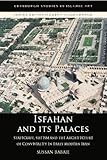Isfahan and its palaces : statecraft, Shi'ism and the architecture of conviviality in early modern Iran / Sussan Babaie
Material type: TextLanguage: English Series: Edinburgh studies in Islamic artEdinburgh : Edinburgh University Press, 2008©2008 Description: xvii, 302 pages, 24 pages of plates : illustrations (some col.) ; 25 cmContent type: text Media type: unmediated Carrier type: volumeISBN: 0748633758 (hardback)Subject(s): Architecture, Safavid -- Iran -- Iṣfahān | Iṣfahān (Iran) -- HistoryLOC classification: NA1487.I8 B33 2008
TextLanguage: English Series: Edinburgh studies in Islamic artEdinburgh : Edinburgh University Press, 2008©2008 Description: xvii, 302 pages, 24 pages of plates : illustrations (some col.) ; 25 cmContent type: text Media type: unmediated Carrier type: volumeISBN: 0748633758 (hardback)Subject(s): Architecture, Safavid -- Iran -- Iṣfahān | Iṣfahān (Iran) -- HistoryLOC classification: NA1487.I8 B33 2008| Item type | Current library | Shelving location | Call number | Copy number | Status | Date due | Barcode |
|---|---|---|---|---|---|---|---|
| Books | MEF Üniversitesi Kütüphanesi | Genel Koleksiyon | NA 1487 .I8 B33 2008 (Browse shelf (Opens below)) | Available | 0012816 |
Includes bibliographical references (pagees [274]-293) and index
Conviviality, charismatic absolutism, and the Persianization of Shi¿¿ism -- Peripatetic kings and palaces : from Tabriz to Qazvin in the sixteenth century -- Dwelling in paradise, or Isfahan "half the world" -- "The abode of felicitious rule" or the Daulatkhane royal precinct -- The spatial choreography of conviviality : the palaces of Isfahan -- Feasting and the Perso-Shi¿¿i etiquette of kingship -- The fall of Isfahan
"An immense building campaign, initiated in 1590-91 at the millennial threshold of the Islamic calendar (1000 A.H.), transformed Isfahan from a provincial, medieval, and largely Sunni city into an urban-centered representation of the first Imami Shi'i empire in the history of Islam.This beautifully illustrated history of Safavid Isfahan (1501-1722) explores the architectural and urban forms and networks of socio-cultural action that reflected a distinctly early-modern and Perso-Shi'i practice of kingship.The historical process of Shi'ification of Safavid Iran and the deployment of the arts in situating the shifts in the politico-religious agenda of the imperial household informs Sussan Babaie's fascinating study."
